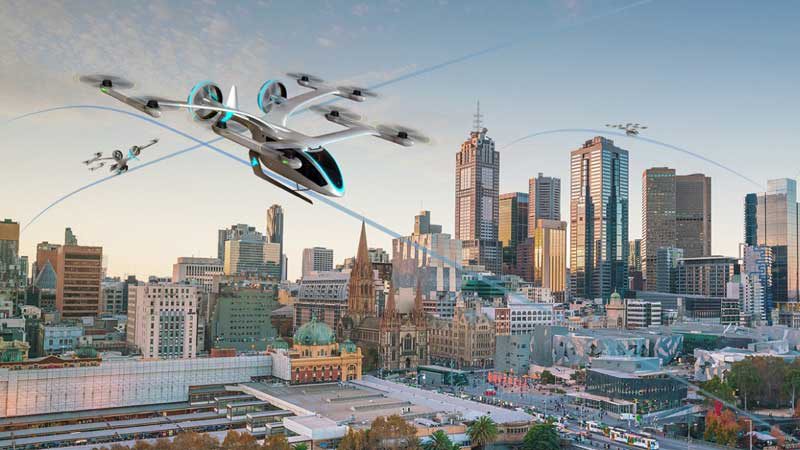The first commercial passenger flight of an electric vertical take-off and landing (eVTOL) aircraft could become a reality in the next three to five years, driven by competition between manufacturers, and backed by billions in investment.
British management consulting firm L.E.K. Consulting as published a new report that says a commercial eVTOL aircraft launch is “just a matter of when”.
“Los Angeles, Paris, China, Singapore, and Seoul are some of the most likely jurisdictions for the first launch of commercial passenger services, based on our analysis of the industry, but we are seeing interest in AAMs across the board, including in Australia,” says co-author Natasha Santha.
It says eVTOL flights in Australia – once such aircraft are certified, and the necessary operator and manufacturing certifications are obtained – would be possible under the country’s existing regulatory framework, undercutting the prevailing idea that bureaucratic red tape would hinder such flights within urban and regional environments.
The authors of the report also expect that the AAM (advanced air mobility) industry could be worth several billions of dollars for a country like Australia, but that it might take up to 8 to 10 years before positive cash flows are the norm.
Globally, the report identifies over 200 aircraft designs in development along with various business models. Many of these designs are already in the design testing phase, with more than 30 companies currently engaging in certification with the US Federal Aviation Administration (FAA), and several in the process of certification with the European Uion Aviation Safety Agency (EASA).
Earlier this year, Japanese multinational Toyota led a $US394 million investment in California-based aerospace company Joby which is developing and commercialising eVTOL aircraft. Similarly, German eVTOL developer Volocopter in February 2020 attracted investment of $US113 million, and China-based EHang’s IPO in late-2019 was valued at $US 650 million.
The report predicts that the advanced air mobility industry could eventually capture approximately 30% of the express post/same-day delivery market, though exact market share will depend on the configuration of existing distribution networks and the comparable cost of road-based delivery mechanisms.
One of the important factors in determining the success of the eVTOL industry is the commitment to the necessary infrastructure costs involved, such as setting up eVTOL ports, or “vertiports” as the report identifies them.
The report suggests that initial vertiport costs could be defrayed by repurposing existing infrastructure such as helipads, or retrofitting existing buildings or developing new structures on underutilised land.
Alternatively, vertiports could be integrated with existing ground transport by being built on or near a train station or bus interchange.
“Ideal locations for the early vertiports are likely to be in built-up areas, connected to existing transport hubs or key destinations (airports, train stations, shopping centres, sporting venues, etc.) meaning the industry should plan for high initial costs,” said Woods.
We have already seen the beginning of designs to place such eVTOL ports in key geographical locations, with the recent decision by Hyundai Motor Group, Coventry City Council, and the UK government to partner with Urban Air Port to launch the world’s first fully-operational hub eVTOL flights.
Turning back to Australia, the report identifies Australia as one country that could be significantly impacted by the AAM industry, with some states already viewed favourably by the international AAM community as potential early launch locations.
“AAM could be a more cost-effective method of providing high-speed connectivity for some city/town pairs, especially where the cost and complication of scaling general aviation, or constructing fixed infrastructure, do not justify the likely patronage demand.”
According to L.E.K. Consulting, “Australia is also well-known internationally for its progressive policy and regulatory settings – a somewhat counter-intuitive conclusion for many of us who are more used to Australia’s restrictive and conservative environmental and climate policy and regulatory settings.
For example, Australia’s Civil Aviation Safety Authority’s (CASA) progressive regulatory stance ensured that Australia would become the first country to support regular commercial urban drone delivery services in 2019.
“AAM has the potential to transform the way we travel to and from our regional centres,” said Santha. “Enhancing connectivity between regional hubs and urban centres will drive significant benefits to the economy and also improve access to employment, education, and services for communities across Australia.
“It will increase the attractiveness of regional areas for investment by other industries, increased tourism and attendance at regional special events.”
Joshua S. Hill is a Melbourne-based journalist who has been writing about climate change, clean technology, and electric vehicles for over 15 years. He has been reporting on electric vehicles and clean technologies for Renew Economy and The Driven since 2012. His preferred mode of transport is his feet.

